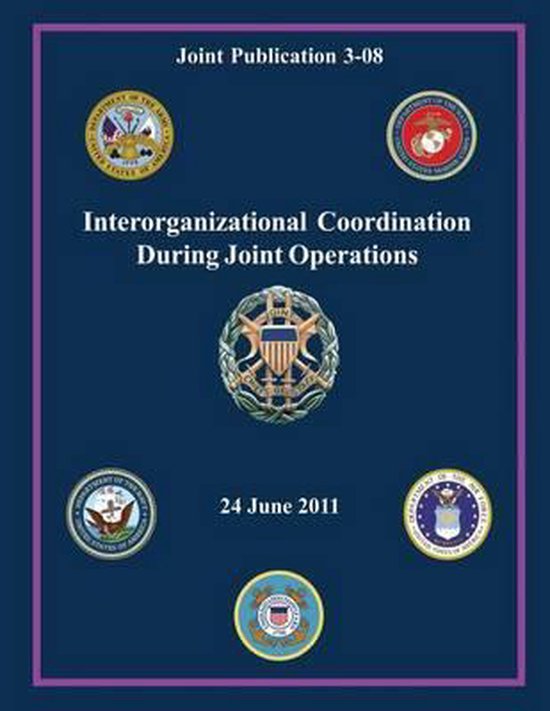Interorganizational Coordination During Joint Operations (Joint Publication 3-08) Joint Publication 3-08
Afbeeldingen
Artikel vergelijken
Uitgever: Createspace Independent Publishing Platform
- Engels
- Paperback
- 9781480200166
- 27 oktober 2012
- 410 pagina's
Samenvatting
This publication provides joint doctrine for the coordination of military operations with US Government agencies; state, local, and tribal governments; intergovernmental organizations, nongovernmental organizations, and the private sector. The Department of Defense conducts interorganizational coordination across a range of operations, with each type of operation involving different communities of interests and structures. This is especially pronounced for domestic and foreign operations, which are governed by different authorities and have considerably different US Government governing structures and stakeholders. Interorganizational coordination aids in this by enabling participants to do one or more of the following: Facilitate Unity of Effort. Achieving national strategic objectives requires the effective and efficient use of diplomatic, informational, military, and economic instruments of national power supported by interorganizational coordination. Achieve Common Objectives. Successful interorganizational coordination enables the USG to build international and domestic support, conserve resources, and conduct coherent operations that more effectively and efficiently achieve common objectives. Provide Common Understanding. Interorganizational coordination is critical to understanding the roles and relationships of participating military commands and relevant stakeholders as well as their interests, equities, and insight into the challenges faced. Such common understandings will be essential to enable stakeholders to operate effectively in the same space, identifying opportunities for cooperation and avoiding unnecessary conflict. Providing Strategic Direction. Strategic direction is the common thread that integrates and synchronizes the activities of the Joint Staff, combatant commands, Services, and combat support agencies. As an overarching term, strategic direction encompasses the processes and products by which the President, Secretary of Defense, and Chairman of the Joint Chiefs of Staff provide policy and strategic guidance to DOD. Strategic direction is provided in a number of national level documents, some of which include the National Security Strategy, National Defense Strategy, National Military Strategy, National Strategy for Combating Terrorism, National Strategy for Combating Weapons of Mass Destruction, National Response Framework, National Strategy for Maritime Security, National Incident Management System, and Unified Command Plan. Within the USG, military and civilian agencies perform in both supported and supporting roles. However, this is not the support command relationship described in Joint Publication 1, Doctrine for the Armed Forces of the United States. Relationships between military and civilian agencies cannot be equated to military command authorities. Although there is no equivalent command relationship between military forces and civilian agencies and organizations, clearly defined relationships may foster harmony and reduce friction between the participants. The incident command system is a standardized on-scene emergency management construct specifically designed to provide for the adoption of an integrated organizational structure that reflects the complexity and demands of single or multiple incidents, without being hindered by jurisdictional boundaries. Military policies, processes, and procedures are very different from those of civilian organizations. This publication has been prepared under the direction of the Chairman of the Joint Chiefs of Staff. It sets forth joint doctrine to govern the activities and performance of the Armed Forces of the United States in joint operations and provides the doctrinal basis for interagency coordination and for US military involvement in multinational operations. It provides military guidance for the exercise of authority by combatant commanders and other joint force commanders and prescribes joint doctrine for operations, education, and training.
Productspecificaties
Wij vonden geen specificaties voor jouw zoekopdracht '{SEARCH}'.
Inhoud
- Taal
- en
- Bindwijze
- Paperback
- Oorspronkelijke releasedatum
- 27 oktober 2012
- Aantal pagina's
- 410
- Illustraties
- Nee
Betrokkenen
- Hoofdauteur
- Chairman Of The Joint Chiefs Of Staff
- Hoofduitgeverij
- Createspace Independent Publishing Platform
Overige kenmerken
- Extra groot lettertype
- Nee
- Product breedte
- 216 mm
- Product hoogte
- 21 mm
- Product lengte
- 280 mm
- Verpakking breedte
- 216 mm
- Verpakking hoogte
- 21 mm
- Verpakking lengte
- 280 mm
- Verpakkingsgewicht
- 943 g
EAN
- EAN
- 9781480200166
Je vindt dit artikel in
- Categorieën
- Taal
- Engels
- Boek, ebook of luisterboek?
- Boek
- Studieboek of algemeen
- Algemene boeken
Kies gewenste uitvoering
Bindwijze
: Paperback
Prijsinformatie en bestellen
Rapporteer dit artikel
Je wilt melding doen van illegale inhoud over dit artikel:
- Ik wil melding doen als klant
- Ik wil melding doen als autoriteit of trusted flagger
- Ik wil melding doen als partner
- Ik wil melding doen als merkhouder
Geen klant, autoriteit, trusted flagger, merkhouder of partner? Gebruik dan onderstaande link om melding te doen.

